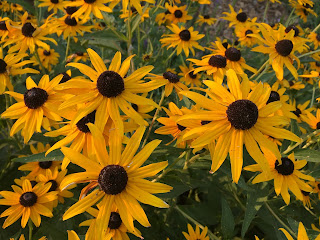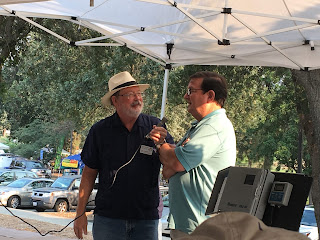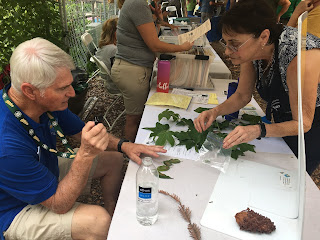

|
| The grape tasting table is a popular stop during Harvest Day. (Photos: Kathy Morrison) |

|
| Rudbeckia brightens the Water Efficient Landscape. |

|
|
This whimsical plant ID
hangs in the vegetable garden. |

|
| "Farmer Fred" Hoffman, left, and Phil Purcell talk trees. |

|
|
Master Gardener Carole Ludlum talks trouble-shooting grapevine
problems. Below, grape clusters in birdproof organza bags. |

|
|
The Master Gardeners' help table was busy all day long.
|

|
|
Choosing blossoms and herbs to make a solar-dyed silk scarf was a fundraising activity at Harvest Day.
|

|
|
Plant vendors such as Morningsun Herb Farm drew many shoppers.
The event also offered food trucks and educational tables. |
Comments
0 comments have been posted.Sacramento Digs Gardening to your inbox.
Sites We Like
Garden Checklist for week of July 21
Your garden needs you!
* Keep your vegetable garden watered, mulched and weeded. Water before 8 a.m. to reduce the chance of fungal infection and to conserve moisture.
* Feed vegetable plants bone meal, rock phosphate or other fertilizers high in phosphate to stimulate more blooms and fruiting. (But wait until daily high temperatures drop out of the 100s.)
* Don’t let tomatoes wilt or dry out completely. Give tomatoes a deep watering two to three times a week.
* Harvest vegetables promptly to encourage plants to produce more. Squash especially tends to grow rapidly in hot weather. Keep an eye on zucchini.
* Pinch back chrysanthemums for bushy plants and more flowers in September.
* Remove spent flowers from roses, daylilies and other bloomers as they finish flowering.
* Pinch off blooms from basil so the plant will grow more leaves.
* Cut back lavender after flowering to promote a second bloom.
* It's not too late to add a splash of color. Plant petunias, snapdragons, zinnias and marigolds.
* From seed, plant corn, pumpkins, radishes, winter squash and sunflowers.